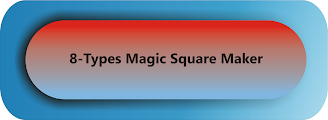In this blog, we will see all the important formulas and useful statements which are to be used in the Math test of GRE.
1) Integers:
1) Integers are positive numbers, negative numbers, and zero like:{ 0, ±1, ±2, ±3, ±4, … }.
2) The product of two positive integers is a positive integer.
3) The product of two negative integers is a positive integer.
4) The product of one positive integer and one negative integer is a negative integer.
5) 1 is a factor of every integer, but not a multiple of any integer except 1 and - 1.
6) 0 is a multiple of every integer, but not a factor of any integer except 0.
7) The sum of two even integers is an even integer.
8) The sum of two odd integers is an even integer.
9) The sum of an even integer and an odd integer is an odd integer.
10) The product of two even integers is an even integer.
11) The product of two odd integers is an odd integer.
12) The product of an even integer and an odd integer is an even integer.
13) An integer greater than 1 is known as Prime Number if it has only two positive divisors,1 and itself.
14) An integer greater than 1 and not a Prime number then it is called a Composite Number.
Rational Numbers
15) A faction is a number of the form a/b, where a and b are integers and b # 0. Such numbers are also called Rational Numbers.
16) In the above form a/b, a is known as the Numerator, and b is known as the Denominator.
17) The Numbers which are not Rational Numbers are called Irrational Numbers.
Real Numbers
18) Union of Rational and Irrational Numbers is known as Real numbers.
19) Set of all real numbers can be represented as a Number line known as Real Number Line.
20) Every left-handed number is smaller than a right-handed number.
22) There are four types of intervals depending on their endpoints.
a) a < x < b, it is both open side intervals denoted by (a, b).
b) a ≤ x < b, it is left hand closed and right hand opened interval and is denoted by [a, b).
c) a < x ≤ b, it is left hand opened and right hand closed interval and is denoted by (a, b].
d) a ≤ x ≤ b, it is both sides closed interval and is denoted by [a, b].
23) An absolute value of a number is the distance of that number from 0 on the number line. It is written as |x| and read as absolute of x. It is always positive.
|x| = 0 if x = 0,
|x| = -x if x < 0,
|x| = x if x > 0,
24) Properties of Real Numbers:
a) Commutative Law:
1) For Addition: a + b = b + a Example: 2 + 3 = 5 = 3 + 2
2) For Multiplication: a * b = b * a Example: 2 * 3 = 6 = 3 * 2
b) Associative Law:
1) For Addition: a + (b + c) = (a + b) + c Example: 2 + (3 + 4) = 9 = (2 + 3) + 4
2) For Multiplication: a * (b * c) = (a * b) * c Example: 2 * (3 * 4) = 24 = (2 * 3) * 4
c) Distributive Law:
1) a * (b + c) = (a * b) + (a * c) Example: 2 * (3 + 4) = 14 = (2 * 3) + (2 * 4)
25) " 0 " is an additive identity. This means 0 + a = a, i. e. 0 + 5 = 5.
26) " 1 " is a multiplicative identity. This means 1 * a = a, i. e. 1 * 7 = 7.
27) Additive inverse of any number x is - x. That is the addition of a number and its additive inverse is the additive identity. x + (-x) = 0.
28) Multiplicative inverse of any number x is 1/x. That is the multiplication of a number and its multiplicative inverse is the multiplicative identity. x * (1/x) = 1.
29) Most important note: 0 * a = 0. Any number multiplied by 0 is always 0. One example will definitely be asked on this basic concept. Please remember this example:
" There are 26 alphabets in English. The highest power of x in the expression ( x - a) (x - b) is 2. whereas in (x - a) (x - b) (x - c) is 3. Like this, we used all 26 alphabets in order to say up to z what is the highest power of x ?"
30) The sum of two positive real numbers is positive.
31) The sum of two negative real numbers is negative.
32) The sum of one positive and one negative number is the difference between them with the sign of the greater number.
33) The product of two positive real numbers is positive.
34) The product of two negative real numbers is positive.
35) The product of one positive and one negative real number is negative.
The next part of this important topic will be published in the next blog.









